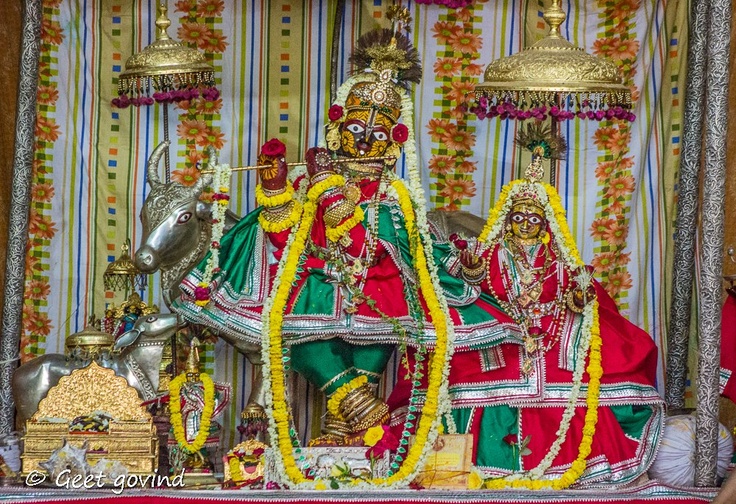Shree Govind Dev Ji Mandir Jaipur: Unravel History & Mystery

The History of Shree Govind Dev Ji Mandir: A Tale of Divine Creation
The origins of Shree Govind Dev Ji Mandir are steeped in legend and mystery. The idol of Govind Dev Ji, believed to be over 5,000 years old, is said to have been crafted by Vajranabh, the great-grandson of Lord Krishna himself. According to folklore, Vajranabh, at the tender age of 13, sculpted three idols based on descriptions from his grandmother, who had seen Krishna in his earthly form. The first idol, Madan Mohan Ji, resembled Krishna’s feet; the second, Gopinath Ji, mirrored his chest; and the third, Govind Dev Ji, captured the divine face of the Lord. This third idol, known as “Bajrakrit,” is the one enshrined in Jaipur today.
But how did this sacred idol travel from Vrindavan to Jaipur? The story takes a dramatic turn during the 16th century. Originally installed in a grand seven-story temple in Vrindavan by Raja Man Singh I in 1590 AD, the idol faced threats during the reign of Mughal Emperor Aurangzeb, who ordered the destruction of Hindu temples. To protect it, the idol was secretly moved by Shri Shiv Ram Goswami, a devoted caretaker, through a perilous journey across villages like Kama, Radhakund, and Govindpura, before finally finding a safe haven in Jaipur under the patronage of Raja Sawai Jai Singh II, the founder of the Pink City. This relocation adds an aura of mystery—why was this idol chosen, and what divine forces guided its journey?
Architectural Marvel: A Blend of Royalty and Divinity
The Shree Govind Dev Ji Mandir in Jaipur is not just a spiritual hub but also an architectural masterpiece. Unlike traditional standalone temples, it resides within the City Palace complex, between Chandra Mahal and Badal Mahal, reflecting the deep bond between the Kachwaha dynasty and Lord Krishna. Built in 1735 by Raja Sawai Jai Singh II, the temple showcases a unique fusion of Rajasthani, Mughal, and classical Indian architectural styles.
The structure is crafted from red sandstone and marble, with a gold-encased ceiling that exudes opulence. Intricate chandeliers, vibrant paintings depicting Krishna’s leelas (divine plays), and delicate carvings adorn the interiors, creating a mesmerizing ambiance. The temple’s Satsang Hall, a grand congregation space, is another highlight, built with 290 tons of steel and 2,000 cubic meters of concrete—a testament to its engineering prowess. Yet, a lingering question remains: why was it designed without a traditional shikhara (spire), unlike most Hindu temples? Some believe it was a deliberate choice to blend seamlessly with the royal palace, symbolizing Krishna as the true king.
Spiritual Significance: Krishna’s Living Presence
For followers of the Gaudiya Vaishnava tradition, Shree Govind Dev Ji Mandir is more than a temple—it’s a portal to Krishna’s divine presence. The idol of Govind Dev Ji, with its lifelike features, is said to resemble Krishna’s earthly incarnation, making it a focal point of devotion. The temple hosts seven aartis daily, each unveiling the deity for darshan, accompanied by soul-stirring bhajans and the offering of bhog. During Janmashtami, the temple transforms into a vibrant celebration, drawing lakhs of devotees who believe that a glimpse of Govind Dev Ji can cleanse the soul.
A mysterious ritual adds to its allure: Radha Rani’s feet are always covered, never revealed to devotees. Some say this is to preserve her divine modesty, while others whisper that her feet hold a secret power too sacred to behold. This enigma continues to intrigue visitors, making the temple a must-visit for spiritual seekers.
The Vrindavan Connection: A Temple Lost to Time
How to Reach Shree Govind Dev Ji Mandir
Planning a visit to Shree Govind Dev Ji Mandir? Here’s how to get there:
- By Air: Fly to Jaipur International Airport (13 km away), then take a taxi or auto-rickshaw to the City Palace complex.
- By Train: Jaipur Junction Railway Station (4 km away) is well-connected to major cities. Hire a cab or local transport to reach the temple.
- By Road: Located at Jainiwas Gardens, Jalebi Chowk, the temple is accessible via NH48 or local buses. Parking is available near City Palace.
- Local Transport: Auto-rickshaws, e-rickshaws, or cabs from anywhere in Jaipur will drop you at the temple entrance.
- Timings: Summer (4:30 AM–12:00 PM, 5:45 PM–9:30 PM); Winter (5:00 AM–12:15 PM, 5:00 PM–8:45 PM).
Why Visit Shree Govind Dev Ji Mandir?
- Spiritual Bliss: Experience the divine energy during the aartis and connect with Krishna’s eternal presence.
- Architectural Wonder: Marvel at the blend of royal and sacred design elements.
- Historical Mystery: Unravel the tales of the idol’s journey and the temple’s resilience.
- Festive Grandeur: Plan your visit during Janmashtami or Holi for an unforgettable celebration.
Temple Timings
- Summer: 4:30 AM–12:00 PM, 5:45 PM–9:30 PM
- Winter: 5:00 AM–12:15 PM, 5:00 PM–8:45 PM
Located at Jainiwas Gardens, Jalebi Chowk, Jaipur, it’s easily accessible by road, rail, or air. Jaipur’s well-connected transport network makes it a convenient stop for temple explorers.
FAQs About Shree Govind Dev Ji Mandir
1. What is Shree Govind Dev Ji Mandir famous for?
It’s renowned as a famous Krishna temple with a 5,000-year-old idol, mysterious history, and stunning architecture in Jaipur’s City Palace.
2. Why was the idol moved from Vrindavan?
To protect it from Aurangzeb’s destruction of Hindu temples, it was relocated to Jaipur by Raja Sawai Jai Singh II.
3. What are the darshan timings?
Summer: 4:30 AM–12:00 PM, 5:45 PM–9:30 PM; Winter: 5:00 AM–12:15 PM, 5:00 PM–8:45 PM, with seven aartis daily.
4. Is photography allowed inside the temple?
No, photography is prohibited inside to maintain sanctity, though you can capture the exterior.
5. How is Shree Govind Dev Ji Mandir different from other temples?
Its location within City Palace, lack of a shikhara, and the idol’s ancient origins make it unique.
